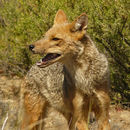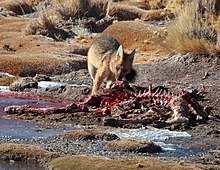en
names in breadcrumbs


Culpeos are omnivores and dietary generalists. Prey range from wild ungulates, hares, sheep, and small mammals to insects, birds, and lizards. Culpeos also eat carrion and fruit. Specific examples of items in a culpeo’s diet are Octodon degus, Oryctolagus cuniculus, and carrion of llamas and vicugnas.
Animal Foods: birds; mammals; reptiles; carrion ; insects; terrestrial non-insect arthropods
Plant Foods: fruit
Primary Diet: carnivore (Eats terrestrial vertebrates); omnivore
Culpeos do not have any complex anti-predator adaptations, because they have few natural enemies. Pumas (Puma concolor) may prey on them occasionally, but this is not an important cause of mortality.
Known Predators:
Anti-predator Adaptations: cryptic
Lycalopex culpaeus is the largest member of the genus Lycalopex. Body weight ranges from 3.4 to 14 kg, with larger individuals occurring at higher latitudes, and males larger and heavier on average than females (11.65 kg compared to 7.82 kg, respectively). Head plus body length ranges from 445 to 925 mm and tail length from 305 to 493 mm. Culpeos vary in color, with lighter individuals in the northern parts of the range. The chin and belly are white to light tawny. The ears, neck, legs, flanks, and top of the head are tawny or reddish-brown. The area around the tail is usually darker, sometimes dark grey. The tail is bushy and grey with a black tip and a darker area near the rump. In the winter months, the fur becomes longer and denser. Larger size and reddish-brown fur distinguish culpeos from similar species.
Range mass: 3.4 to 14 kg.
Range length: 445 to 925 mm.
Other Physical Features: endothermic ; homoiothermic; bilateral symmetry
Sexual Dimorphism: male larger
Not much is known about the lifespan of culpeos. The oldest culpeo discovered in the wild was estimated to be 11 years old. However, the method of aging was not defined, so the accuracy of this estimate is unknown.
Range lifespan
Status: wild: 11 (high) years.
Culpeos are generalists when it comes to habitat selection. They can be found in the high-altitude foothills of the Andes and in the valleys surrounding them. Culpeos have been reported from 0 to 4500 m above sea level. Their habitat ranges from the forests of western and southern South America to the desert of the Patagonia region. Scrub and grassland are also occupied by culpeos.
Range elevation: 0 to 4500 m.
Habitat Regions: temperate ; tropical ; terrestrial
Terrestrial Biomes: desert or dune ; savanna or grassland ; chaparral ; forest ; rainforest ; scrub forest ; mountains
Culpeos (Lycalopex culpaeus) are found in South America from Ecuador to southern Chile and Argentina. They are found throughout the Andes and the Patagonian steppe of Argentina. They may also occur in the Narino Province of southern Colombia, but this is still uncertain.
Biogeographic Regions: neotropical (Native )
Culpeos serve important ecological roles. As predators on many different species, culpeos play a role in population control, and as prey and host, they provide energy to higher trophic levels. Also, culpeos eat fruit and are important in seed dispersal. The seeds of peumo (Cryptocarya alba) and Peruvian pepper (Schinus molle) have been recorded to germinate at higher rates if defecated by culpeos. Additionally, culpeos assist in biodegradation, by eating the carrion of other species.
Ecosystem Impact: disperses seeds; biodegradation
Commensal/Parasitic Species:
Culpeos have long been hunted and trapped for their fur, providing an important source of income to inhabitants of Chile and Argentina. Also, culpeos eat carrion, which provides an important service to the ecosystem that could be seen as a benefit to humans.
Positive Impacts: body parts are source of valuable material
Culpeos occasionally feed on livestock, such as sheep and chickens, and are said to be a major cause of sheep predation in Patagonia.
Lycalopex culpaeus appears to be able to withstand human hunting pressure and is maintaining a stable population.
US Federal List: no special status
CITES: appendix ii
State of Michigan List: no special status
IUCN Red List of Threatened Species: least concern
Lycalopex culpaeus communication in the wild has not been described. In captivity, culpeos make a mixed growl and scream noise. Like other canids, they are likely to use a broad suite of physical cues, scents, postures, and sounds to communicate.
Communication Channels: visual ; tactile ; acoustic ; chemical
Other Communication Modes: scent marks
Perception Channels: visual ; tactile ; acoustic ; chemical
Lycalopex culpaeus were previously known as Pseudalopex culpaeus.
Not much is known about the mating system of Lycalopex culpaeus. Closely related Argentine gray foxes, Lycalopex griseus, are monogamous, with the mated pair defending an exclusive territory. A second female may assist in taking care of young. Another member of this genus, Lycalopex fulvipes, also appears to be monogamous.
Lycalopex culpaeus females go into heat (estrus) from early August to October and are monestrous. Males produce sperm from June to mid-October. Gestation lasts for 55 to 60 days and the average litter size is 5.2. Newborns weigh 170 g on average and are born with their eyes closed. Weaning occurs at two months and young grow to full size within seven months. Sexual maturity occurs after one year.
Breeding interval: Culpeos breed once yearly.
Breeding season: Mating occurs from early August to October.
Range number of offspring: 3 to 8 .
Average number of offspring: 5.2 .
Range gestation period: 55 to 60 days.
Average weaning age: 2 months.
Average age at sexual or reproductive maturity (female): 1 years.
Average age at sexual or reproductive maturity (male): 1 years.
Key Reproductive Features: iteroparous ; seasonal breeding ; gonochoric/gonochoristic/dioecious (sexes separate); sexual ; viviparous
Not much is known about parental care in Lycalopex culpaeus. The species is generally solitary, but it has been reported that both parents might play a role in the care of offspring. As in other mammals, females nurse and care for the young extensively after gestation.
Parental Investment: altricial ; male parental care ; female parental care ; pre-fertilization (Provisioning, Protecting: Female); pre-hatching/birth (Provisioning: Female, Protecting: Female); pre-weaning/fledging (Provisioning: Female, Protecting: Female)
The culpeo (Lycalopex culpaeus), also known as culpeo zorro, Andean zorro, Andean fox, Paramo wolf,[3] Andean wolf,[4] and colpeo fox,[4] is a species of South American fox. Regardless of the name, it is not a true fox, but more closely related to wolves and jackals. Its appearance resembles that of foxes due to convergent evolution.
The culpeo's diet consists largely of rodents, rabbits, birds and lizards, and to a lesser extent, plant material and carrion. They may prey on Andean flamingos and baby vicuña. The culpeo occasionally attacks sheep and is, therefore, often hunted or poisoned.[5] In some regions, it has become rare, but overall the species is not threatened with extinction.
The culpeo was domesticated by the Selk'nam people of Tierra del Fuego, producing the Fuegian dog which became extinct in the late 19th or early 20th century.[6]
The culpeo is a canid intermediate in size between a red fox and a coyote. It is the second-largest native canid on the continent after the maned wolf. In appearance, it bears many similarities to the widely recognized red fox. It has grey and reddish fur, a white chin, reddish legs and a stripe on its back that may be barely visible. The average weight of the male is 11.4 kg (25 lb), while the typically smaller females average 8.4 kg (19 lb). Overall, a weight range of 5 to 13.5 kg (11 to 30 lb) has been reported. Total length can range from 94 to 133 cm (37 to 52 in), including a tail of 32 to 44 cm (13 to 17 in) in length.[7] The pelt has a grizzled appearance. The neck and shoulders are often tawny to rufous in color, while the upper back is dark. The bushy tail has a black tip.[8]

The culpeo's range extends from the southern regions of Patagonia and Tierra del Fuego in the south to Ecuador and Peru in the north, with some populations extending into southern Colombia. It is also found in the Sierras Grandes mountain range in Córdoba, Argentina.[9] It is most common on the western slopes of the Andes, where it inhabits open country and deciduous forests.
The culpeo lives in a wide variety of habitats of western South America. They are found in broadleaf Nothofagus temperate rainforest, sclerophyllous matorral, deserts, chaparrals, and plateaus, like the Altiplano, up to the tree line (4,800 metres (15,700 ft)).[1]

The culpeo is an opportunistic predator that will take any variety of prey. It mainly feeds on rodents (including common degus) and lagomorphs (especially the introduced European rabbit and European hare); however, it occasionally feeds on domestic livestock and young guanacos.[10][11] They will also feed on insects, birds, lizards, fruit, and carrion of llamas and vicuñas.[12] Culpeos are considered beneficial because they are significant predators of the rabbits introduced in 1915; such introduced rabbit populations are believed to have allowed culpeos to spread from the Andean foothills across the Patagonian plain.[13] They sometimes take young lambs up to 1 week old. In limited studies, the larger culpeo appears to dominate potential competitors, including South American gray foxes, Geoffroy's cats, pampas cats, grisons and various raptorial birds.[8] Its range also overlaps that of the much larger puma, but the size difference ensures that the two species have limited competition. They are known to eat the carcasses of vicuñas. Culpeos have also been observed preying upon introduced beavers in Tierra del Fuego.[14] During a period of drought in central Chile's scrublands lagomorphs, coati, goats, and cattle make up a large amount of their diet.[15]
The typical mating period is between August and October. After a gestation period of 55–60 days, the female gives birth usually to between two and five pups.
The taxonomy of the culpeo has been the topic of debate due to their high phenetic variability and the scarcity of research, among other things. Over the past three decades, they have been placed variably in the genera Dusicyon (Clutton-Brock, et al., 1976; Wozencraft, 1989), Canis (Langguth, 1975; Van Gelder, 1978), Pseudalopex (Berta, 1987; Wozencraft, 1993; Tedford et al., 1995) and Lycalopex (Zunino, 1995; Wozencraft, 2005).[16]
This canid, like other South American foxes, is still sometimes classified as a member of the genus Pseudalopex.[1] As Pseudalopex and Lycalopex have largely come to describe the same genus, either classification is acceptable, although the modern practice is to give Lycalopex prominence.[17]
Culpeo[18]
The culpeo (Lycalopex culpaeus), also known as culpeo zorro, Andean zorro, Andean fox, Paramo wolf, Andean wolf, and colpeo fox, is a species of South American fox. Regardless of the name, it is not a true fox, but more closely related to wolves and jackals. Its appearance resembles that of foxes due to convergent evolution.
The culpeo's diet consists largely of rodents, rabbits, birds and lizards, and to a lesser extent, plant material and carrion. They may prey on Andean flamingos and baby vicuña. The culpeo occasionally attacks sheep and is, therefore, often hunted or poisoned. In some regions, it has become rare, but overall the species is not threatened with extinction.
The culpeo was domesticated by the Selk'nam people of Tierra del Fuego, producing the Fuegian dog which became extinct in the late 19th or early 20th century.